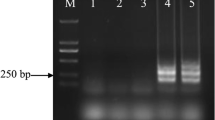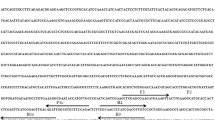Abstract
A set of six specific primers was designed by targeting intergenic spacer region (IGS) sequences. With Bst DNA polymerase, the products could be clearly amplified for 60 min at 62°C in a simple water bath. The sensitivity of the loop-mediated isothermal amplification (LAMP) for detecting Metarhizium anisopliae var. anisopliae was about 0.01 pg fungal DNA per reaction (equivalent to 27 conidia). LAMP products could be judged with agar gel or naked eye after addition of SYBR Green I. There were no cross reactions with other fungal isolates indicating high specificity of the LAMP. The LAMP could detect the presence of M. anisopliae var. anisopliae from soil. The detection limits for M. anisopliae var. anisopliae of LAMP reaction was 50 conidia per reaction in soil.




Similar content being viewed by others
References
Bridge PD, Prior C, Sagbohan J, Lomer CJ, Carey M, Buddie A (1997) Molecular characterization of isolates of Metarhizium from locusts and grasshoppers. Biodivers Conserv 6:177–189
Cai SH, Lu YS, Wu ZH, Jian JC, Wang B, Huang YC (2010) Loop-mediated isothermal amplification method for rapid detection of Vibrio alginolyticus, the causative agent of vibriosis in mariculture fish. Lett Appl Microbiol 50:480–485
Endo S, Komori T, Ricci G, Sano A, Yokoyama K, Ohori A, Kamei K, Franco M, Miyajim M, Nishimura K (2004) Detection of gp43 of Paracoccidioides brasiliensis by the loop-mediated isothermal amplification (LAMP) method. FEMS Microbiol Lett 234:93–97
Entz SC, Johnson DL, Kawchuk LM (2005) Development of a PCR-based diagnostic assay for the specific detection of the entomopathogenic fungus Metarhizium anisopliae var. acridum. Mycol Res 109:1302–1312
Gadkar V, Rillig MC (2008) Evaluation of loop-mediated isothermal amplification (LAMP) to rapidly detect arbuscular mycorrhizal fungi. Soil Biol Biochem 40:540–543
Gillespie AT, Claydon N (1989) The use of entomopathogenic fungi for pest control and the role of toxins in pathogenesis. Pestic Sci 27:203–215
Hasegawa E, Ota Y, Hattori T, Kikuchi T (2010) Sequence-based identification of Japanese Armillaria species using the elongation factor-1 alpha gene. Mycologia 102:898–910
Hughes WO, Thomsen L, Eilenberg J, Boomsma JJ (2004) Diversity of entomopathogenic fungi near leaf-cutting ant nests in a neotropical forest, with particular reference to Metarhizium anisopliae var. anisopliae. J Invertebr Pathol 85:46–53
Liu SD, Lin SC, Shiau JF (1989) Microbial control of coconut leaf beetle (Brontispa longissima) with green muscardine fungus, Metarhizium anisopliae var. anisopliae. J Invertebr Pathol 53:307–314
Mavridou A, Typas MA (1998) Intraspecific polymorphism in Metarhizium anisopliae var. anisopliae revealed by analysis of rRNA gene complex and mtDNA RFLPs. Mycol Res 102:1233–1241
Notomi T, Okayama H, Masubuchi H, Yonekawa T, Watanabe K, Amino N, Hase T (2000) Loop-mediated isothermal amplification of DNA. Nucleic Acids Res 28:e63
Pantou MP, Mavridou A, Typas MA (2003) IGS sequence variation, group-I introns and the complete nuclear ribosomal DNA of the entomopathogenic fungus Metarhizium: excellent tools for isolate detection and phylogenetic analysis. Fungal Genet Biol 38:159–174
Sampietro DA, Marín P, Iglesias J, Presello DA, Vattuone MA, Catalan CA, Gonzalez Jaen MT (2010) A molecular based strategy for rapid diagnosis of toxigenic Fusarium species associated to cereal grains from Argentina. Fungal Biol 114:74–81
Samuels RI, Charnley AK, Reynolds SE (1988) The role of destruxins in the pathogenicity of 3 strains of Metarhizium anisopliae for the tobacco hornworm Manduca sexta. Mycopathologia 104:51–58
St Leger RJ, Joshi L, Bidochka MJ, Roberts DW (1996) Construction of an improved mycoinsecticide overexpressing a toxic protease. Proc Natl Acad Sci USA 93:6349–6354
Xia Y, Dean P, Judge AJ, Gillespie JP, Clarkson JM, Charnley AK (2000) Acid phosphatases in the haemolymph of the desert locust, Schistocerca gregaria, infected with the entomopathogenic fungus Metarhizium anisopliae. J Insect Physiol 46:1249–1257
Acknowledgments
The authors thank the relevant fellows of Guangdong provincial key laboratory of pathogenic biology and epidemiology for aquatic economic animals for providing the necessary equipments. The authors also thank all the people who have dedicated their valuable time to conduct the experiments.
Author information
Authors and Affiliations
Corresponding author
Rights and permissions
About this article
Cite this article
Li, Y., Cai, SH. Sensitive and Rapid Detection of the Insect Pathogenic Fungus Metarhizium anisopliae var. anisopliae by Loop-mediated Isothermal Amplification. Curr Microbiol 62, 1400–1404 (2011). https://doi.org/10.1007/s00284-011-9872-x
Received:
Accepted:
Published:
Issue Date:
DOI: https://doi.org/10.1007/s00284-011-9872-x




